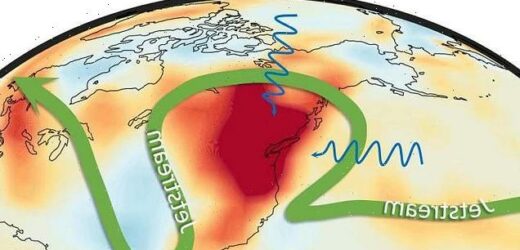Britain’s record 40C temperatures could be the norm within 30 years: Scientists warn number of extreme heatwaves will increase by more than 30% by 2050
- Britain’s record 40C temperatures will be the norm within three decades – study
- Warns extreme heatwaves to increase by more than 30 per cent in coming years
- Scientists say the burning of fossil fuels and other human activities are to blame
- Simulations found greenhouse gases are the reason for increased temperatures
It may have been Britain’s hottest day in history this week, but researchers warn such 40C temperatures won’t be out of the ordinary within the next three decades.
A new study suggests that extreme heatwaves will increase by more than 30 per cent over the coming years, after being fuelled by the burning of fossil fuels and other human activities.
Tuesday was the hottest day ever recorded in the UK, with the mercury surpassing 40.3C (104F).
But it serves as an early preview of what climate forecasters believe will be typical summer weather by 2050.
A new study, which analysed atmospheric circulation patterns and greenhouse gases, looked at data from just over a year ago when nearly 1,500 people died as average temperatures in the US and Canada more than doubled.
Warning: A new study suggests extreme heatwaves will increase by more than 30 per cent in the next three decades. The shading in the image above represents surface air temperature anomalies, while the green vector denotes the jetstream. Two blue vectors show a heatwave that hit the US last year was linked to anomalous circulations in the North Pacific and the Arctic
BILLIONS MORE WILL NEED ACCESS TO AIR CONDITIONING AS EXTREME HEAT RISES
As extreme heatwaves ravage the US, Europe and Africa, killing thousands, scientists warn that the worst is still to come.
With countries continuing to pump greenhouse gases into the atmosphere, experts warn that this summer’s sweltering temperatures may seem mild in 30 years.
Air conditioning, a technology many take for granted in the world’s wealthiest nations, is a life-saving tool during extreme heatwaves.
However, only about 8 per cent of the 2.8 billion people living in the hottest – and often poorest – parts of the world currently have it in their homes.
In a recent paper, a team of researchers from the Harvard modelled the future demand for air conditioning as days with extreme heat increase globally.
They found a massive gap between current air conditioning capacity and what will be needed by 2050 to save lives, especially in low-income and developing countries.
The researchers estimated that, on average, at least 70 per cent of the population in several countries will require air conditioning by 2050 if the rate of emissions continues to increase, with that number even higher in equatorial countries like India and Indonesia.
Even if the world meets the emissions thresholds laid out in the Paris Climate Accords –which it’s not on track to do – an average of 40 per cent to 50 per cent of the population in many of the world’s warmest countries will still require air conditioning.
Co-author Dr Chunzai Wang, of the South China Sea Institute of Oceanology, said: ‘An extraordinary and unprecedented heatwave swept western North America in late June of 2021.
‘It resulted in hundreds of deaths and a massive die off of sea creatures off the coast as well as horrific wildfires.
‘In this paper, we studied the physical processes of internal variability, such as atmospheric circulation patterns, and external forcing, such as anthropogenic (manmade) greenhouse gases.’
Computer simulations found that greenhouse gases are the main reason for increased temperatures, which the research team said would keep rising and lead to more frequent and extreme heatwaves in the future.
Atmospheric circulation patterns, meanwhile, describe how air flows and influences surface temperatures around the planet.
Both can change based on natural warming from the sun, intrinsic atmospheric processes and Earth’s rotation.
These configurations are responsible for daily weather, as well as long-term patterns comprising climate.
Using observational data and climate models, the researchers identified three specific ocean temperature phenomena during the 2021 heatwave.
They are known as the North Pacific, the Arctic-Pacific Canada, and the North America patterns.
Dr Wang said: ‘The North Pacific pattern and the Arctic-Pacific Canada pattern co-occurred with the development and mature phases of the heatwave, whereas the North America pattern coincided with the decaying and eastward movements of the heatwave.
‘This suggests the heatwave originated from the North Pacific and the Arctic, while the North America pattern ushered the heatwave out.’
The findings may also explain the UK’s current heatwave, the researchers said.
However, the three atmospheric circulation patterns have overlapped before without triggering an extreme heatwave.
Dr Wang added: ‘We found it is likely global warming associated with greenhouse gases influences these three atmospheric circulation pattern variabilities, which, in turn, led to a more extreme heatwave event.
‘If appropriate measures are not taken, the occurrence probability of extreme heatwaves will increase and further impact the ecological balance, as well as sustainable social and economic development.’
The 40C (104F) landmark was reached for the first time in the UK, at Heathrow airport. The previous record, of 38.7C in 2019, fell when 39.1C was recorded at Charlwood in Surrey.
Then 40.2C was reported at Heathrow at 12.50pm, before 40.3 (104.5F) was registered at Coningsby, Lincolnshire.
Tuesday’s soaring temperatures came after the hottest night on record. The highest minimum temperature in a 24-hour period was recorded in Kenley, south London, of 25.8C in the 24 hours to 10am.
Transport secretary Grant Shapps admitted it would take decades to make road and rail infrastructure resilient enough to cope.
Meanwhile, wildfires have swept across Europe and the US, where more than a third of the country is under heat warnings.
The research has been published in the journal Advances in Atmospheric Sciences.
THE PARIS AGREEMENT: A GLOBAL ACCORD TO LIMIT TEMPERATURE RISES THROUGH CARBON EMISSION REDUCTION TARGETS
The Paris Agreement, which was first signed in 2015, is an international agreement to control and limit climate change.
It hopes to hold the increase in the global average temperature to below 2°C (3.6ºF) ‘and to pursue efforts to limit the temperature increase to 1.5°C (2.7°F)’.
It seems the more ambitious goal of restricting global warming to 1.5°C (2.7°F) may be more important than ever, according to previous research which claims 25 per cent of the world could see a significant increase in drier conditions.
The Paris Agreement on Climate Change has four main goals with regards to reducing emissions:
1) A long-term goal of keeping the increase in global average temperature to well below 2°C above pre-industrial levels
2) To aim to limit the increase to 1.5°C, since this would significantly reduce risks and the impacts of climate change
3) Governments agreed on the need for global emissions to peak as soon as possible, recognising that this will take longer for developing countries
4) To undertake rapid reductions thereafter in accordance with the best available science
Source: European Commission
Source: Read Full Article



